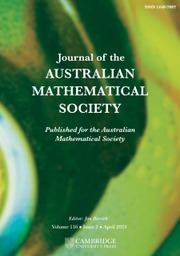Article contents
Digit patterns and transcendental numbers
Published online by Cambridge University Press: 09 April 2009
Abstract
We use a theorem of Loxton and van der Poorten to prove the transcendence of certain real numbers defined by digit patterns. Among the results we prove are the following. If k is an integer at least 2, P is any nonzero pattern of digits base k, and  counts the number of occurrences (mod r) of p in the base k representation of n, then
counts the number of occurrences (mod r) of p in the base k representation of n, then  is transcendental except when k = 3, P = 1 and r = 2. When (r, k − 1) = 1 the linear span of the numbers
is transcendental except when k = 3, P = 1 and r = 2. When (r, k − 1) = 1 the linear span of the numbers  has infinite dimension over Q, where P ranges over all patterns base k without leading zeros.
has infinite dimension over Q, where P ranges over all patterns base k without leading zeros.
MSC classification
- Type
- Research Article
- Information
- Copyright
- Copyright © Australian Mathematical Society 1991
References
- 4
- Cited by


